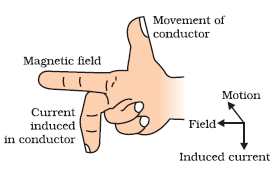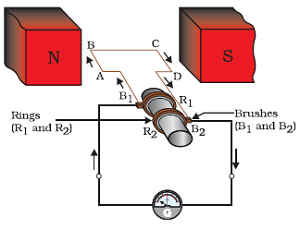Magnetic Effects of Electric Current - Class 10th Science
Electromagnetic Induction
Michael Faraday, an English Physicist first observed that when a conductor is placed to move inside a magnetic field or a magnetic field is changing around a fixed conductor, electric current is induced or generated in the conductor.
When magnetic field is produced by electromagnet and a conductor is set to move inside the magnetic field, electric current is induced or generated in the conductor. Since, this current is induced by the magnetic field produced by an electromagnet, thus, this is called ELECTROMAGNETIC INDUCTION.
The induced current is found to be highest when direction of motion of the coil is at right angles to the magnetic field.
Fleming's Right Hand Rule
Fleming's Right Hand Rule states about the direction of induced current. When thumb, forefinger and middle finger of right hand is stretched in such a fashion that they are perpendicular to each other, then if the forefinger indicates the direction of the magnetic field and thumb shows the direction of motion of conductor, then the middle finger will show the direction of induced current.

Electromagnetic induction is used to generator electric current using electric generator.
Electric Generator
Electric generator is a device which converts mechanical energy into electrical energy. Electric generator works just in the opposite way as an electric motor.
Structure of Electric Generator:

- Electric generator looks more or less similar to an electric motor. The only difference is that a permanent magnet is used instead of an electromagnet.
- A rectangular coil ABCD; placed between the two poles of a magnet.
- The two ends of the coil are attached to two rings R1 and R2. The rings are insulated and are fixed on an axle.
- Each ring touches a brush; which are shown by B1 and B2 in the given figure.
- The outer ends of the brushes are attached to a galvanometer which shows the magnitude of electric current produced.
- Axle is rotated mechanically so that the coil can rotate.
Working of Electric Generator
- When the axle is rotated in order to move the coil; the arm AB of the coil moves up and the arm CD moves down.
- Due to Fleming's Right Hand rule, electric current is induced which flows from AB to CD and thus the current moves from the brush B2 to B1. Thus, the induced current moves in the direction ABCD.
- Large number of turns; in the coil; results in add-on effect to produce a large amount of current.
After half a turn of the coil; the arm CD reaches the position earlier occupied by arm AB and vice-versa. This means that in the next half-turn, arm CD moves up and arm AB moves down. In this case, the induced current flows from DC to BA. This means that there is a change in polarity of the induced current after every half turn. The current which changes directions after frequent intervals is called Alternating Current (AC). This is the reason this device is also called AC Generator.
If one wants to get direct current (DC) from the generator then one needs to add a split ring commutator to the device. The split ring commutator ensures that one brush is always in contact with the arm of rectangular coil which is moving up.
Alternating Current (AC) and Direct Current (DC)
Electric current which changes direction after equal interval of time is called ALTERNATING CURRENT (AC).
Electric current which does not change direction with time is called DIRECT CURRENT (DC).
Direct current always flows in one direction while alternating current reverses its direction periodically. Most of the power stations these days produced alternating current (AC).
Alternating Current in India
In India, the alternating current changes its direction after every 1/100 second, this means the frequency of alternating current is 50 Hz.
Advantage of Alternating Current
Alternating Current (AC) has an important advantage over Direct Current (DC). Alternating current can be transmitted over long distances without much loss of energy. This is the cause that most of the power stations are conducted to produce Alternating current (AC).